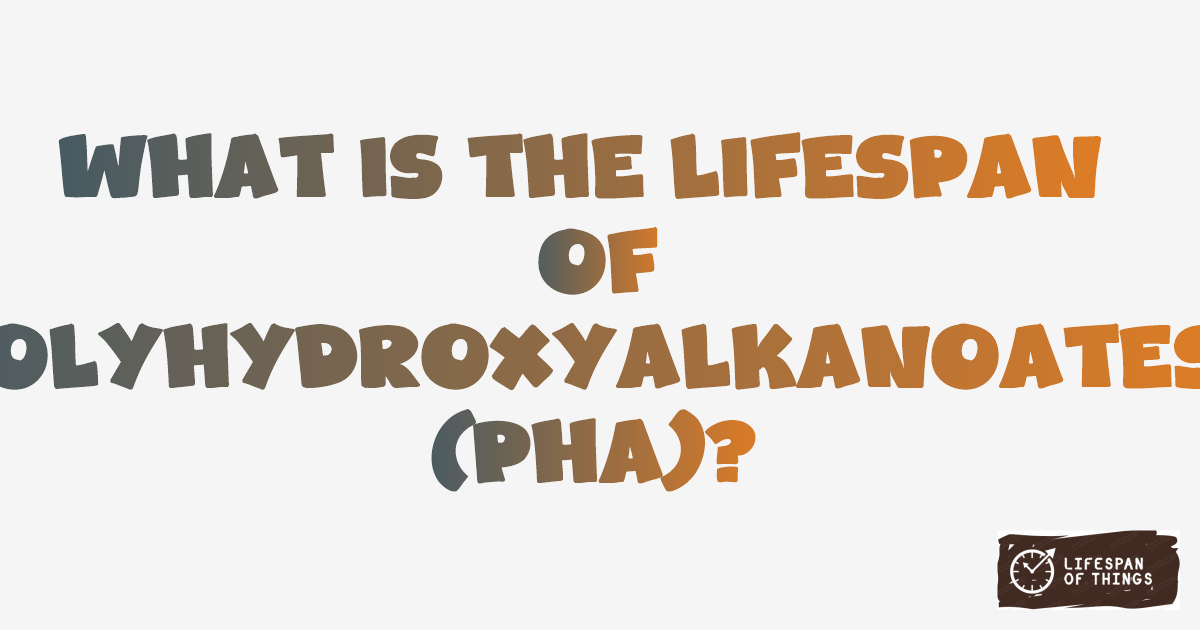
5 - 10 Years
Lifespan of Polyhydroxyalkanoates (PHA) is 5 - 10 Years. Factors like temperature, moisture, and pressure can influence how long PHA lasts. Proper storage and handling can extend its lifespan and durability.
Useful Information
Polyhydroxyalkanoates (PHA) exhibit strength, flexibility, and biodegradability. Various types of PHA exist, each with unique properties such as enhanced biocompatibility or thermal stability.
PHA finds applications in packaging, medical devices, and agricultural materials. Its biodegradability makes it suitable for sustainable products in industries promoting eco-friendly practices.
Explore how bioplastics are used in packaging, agriculture, and medical devices, offering biodegradable solutions for a more sustainable future. Read more
The durability of PHA is affected by factors like exposure to UV light and humidity. Storing PHA in cool, dry environments can help prolong its lifespan. Avoiding harsh chemicals or extreme temperatures can preserve its integrity.
Production and disposal of PHA have a lower environmental impact compared to conventional plastics. Choosing PHA supports the shift towards greener alternatives in reducing plastic waste. Biodegradable PHA offers a more sustainable option for single-use plastics.
To maintain PHA, store it away from direct sunlight and extreme temperatures. Clean with mild soap and water, avoiding abrasive cleaners. Repair minor damages promptly to prevent further deterioration. Proper care can ensure PHA retains its properties and functionality over time.
Lifespan Comparisons
| Compared Item | Comparison Description |
|---|---|
| Lifespan of Polylactic Acid (PLA) | Polyhydroxyalkanoates (PHA) and Polylactic Acid (PLA) have similar lifespans, lasting around 5-10 years each. |
| Lifespan of Starch-Based Plastics | Polyhydroxyalkanoates (PHA) and Starch-Based Plastics have comparable lifespans, lasting approximately 5-10 years. |
| Lifespan of Cellulose-Based Plastics | Polyhydroxyalkanoates (PHA) differs from Cellulose-Based Plastics, as the former lasts significantly less than the latter. |
| Lifespan of Polybutylene Succinate (PBS) | Polyhydroxyalkanoates (PHA) outlasts Polybutylene Succinate (PBS) by a few years in terms of lifespan. |
| Lifespan of Cordura | Compared to Cordura, Polyhydroxyalkanoates (PHA) offers a similar lifespan, lasting around 5-10 years. |
| Lifespan of Organic Cotton | Organic Cotton and Polyhydroxyalkanoates (PHA) share a similar lifespan, both lasting approximately 5-10 years. |
| Lifespan of Bamboo Fabric | Bamboo Fabric lasts slightly longer than Polyhydroxyalkanoates (PHA) in terms of lifespan, lasting around 10-15 years. |
| Lifespan of Recycled Polyester | Recycled Polyester has a similar lifespan to Polyhydroxyalkanoates (PHA), lasting approximately 5-15 years. |
| Lifespan of Europa (Jupiter) | Polyhydroxyalkanoates (PHA) last significantly shorter compared to Europa (Jupiter), which has a lifespan measured in light years. |
| Lifespan of Titan (Saturn) | When compared to Titan (Saturn), Polyhydroxyalkanoates (PHA) have a notably shorter lifespan. |
| Lifespan of Io (Jupiter) | Polyhydroxyalkanoates (PHA) have a lifespan shorter than that of Io (Jupiter), a celestial body within our solar system. |
| Lifespan of Ganymede (Jupiter) | Polyhydroxyalkanoates (PHA) have a significantly shorter lifespan than Ganymede (Jupiter), which endures for several decades. |
| Lifespan of Milky Way | Comparatively, the lifespan of Polyhydroxyalkanoates (PHA) is shorter than that of the Milky Way galaxy. |
| Lifespan of Andromeda | In contrast to Andromeda, Polyhydroxyalkanoates (PHA) have a notably shorter lifespan. |
| Lifespan of Whirlpool Galaxy | Polyhydroxyalkanoates (PHA) have a significantly shorter lifespan than the Whirlpool Galaxy, which has an incredibly long lifespan. |
Frequently Asked Questions
Lifespan of Polyhydroxyalkanoates (PHA) is 5 - 10 Years.
Factors like exposure to UV light and humidity can affect the durability of PHA. Storing it properly can help maintain its integrity.
Polyhydroxyalkanoates (PHA) are commonly used in packaging, medical devices, and agricultural materials due to their biodegradability and strength.
PHA has a lower environmental impact in production and disposal compared to traditional plastics, making it a more sustainable choice for reducing plastic waste.
To preserve the properties and functionality of PHA, store it away from direct sunlight, clean it with mild soap and water, and promptly repair any minor damages.








